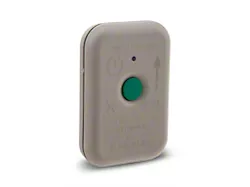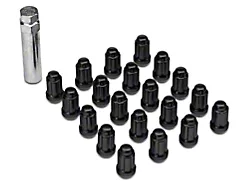
Best Sellers
Powerslot Mustang Rotors (Rear Pair '94-'04 GT/V6) - Installation Instructions
Installation Time
2 hours
Tools Required
- Breaker bar
- Torque wrench (capable of measuring 80ft-lbs)
- Ratchet
- 13mm, 15mm and 21mm sockets
- 11mm and 3/8 wrenches
- Rubber mallet
- Rear Brake Compressor Kit (this can be rented from Schucks/OReillys Auto Supply for free as Kit #48)
- Clear glass jar with lid
- 3/16 Rubber hose approximately 1 long
- Brake part lubricant (this should come with your Hawk HP-Plus pads)
- Brake cleaner
- Paper towel
- Penetrating Oil
- Latex Gloves
- Floorjack, two jackstands, and wheelchock
- Drill
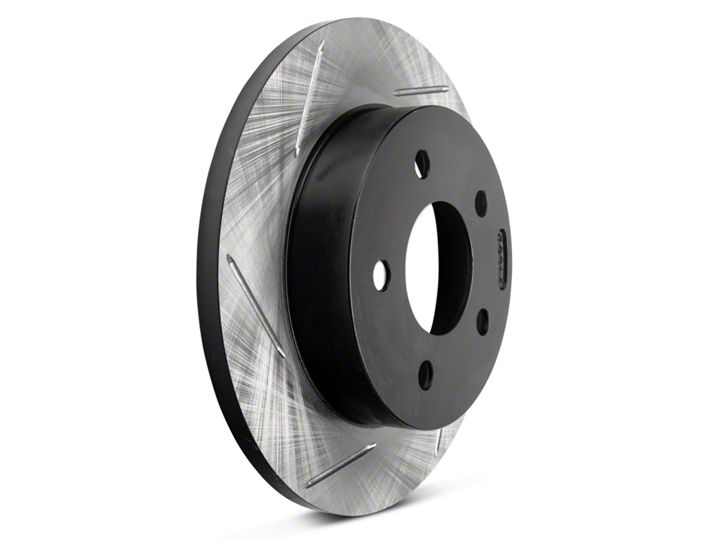
Shop Parts in this Guide
Installation
Brake Bleeding Tool Construction:
1. To construct this apparatus, you need (1) glass jar with a lid and (1) length of rubber hose.
2. Drill a hole in the jar lid that is just a little bit smaller in diameter than the outer diameter of the rubber tubing.
3. Stick the rubber tubing into the hole in the jar lid.
4. Screw the jar lid onto the jar.
5.Now you have a brake-bleeding tool.
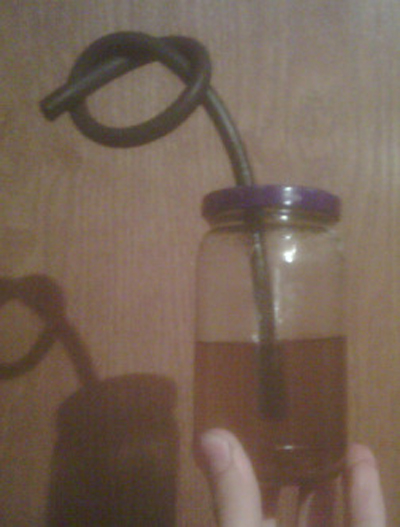
Brake Bleeding Tool
Installation
1. Break the five lug nuts loose on each of the front wheels with the breaker bar and 21mm socket. Warning! Do not loosen bolts any further than the initial break at this time!
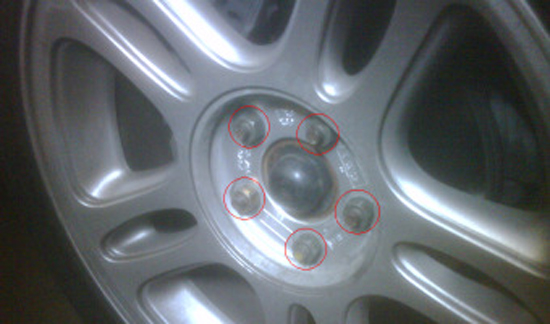
Passenger wheel with lug nuts circled in red.
2. Chock one of the front wheels with the wheel chock. Then jack the rear of the car up just far enough that the rear wheels lift off the ground. Secure the car with the two jackstands.
NOTE:The rest of the instructions are for the passenger side only. Repeat them for the driver side when complete.
3. Remove the lugnuts with the ratchet, 3” extension, and 21mm socket. Then remove the wheel from the wheel studs.
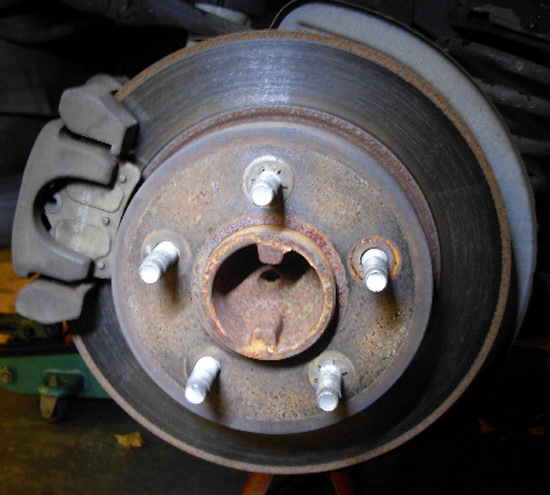
Wheel hub with wheel removed.
4. Remove two caliper bolts with the 13mm socket. Refer to picture below for bolt locations.
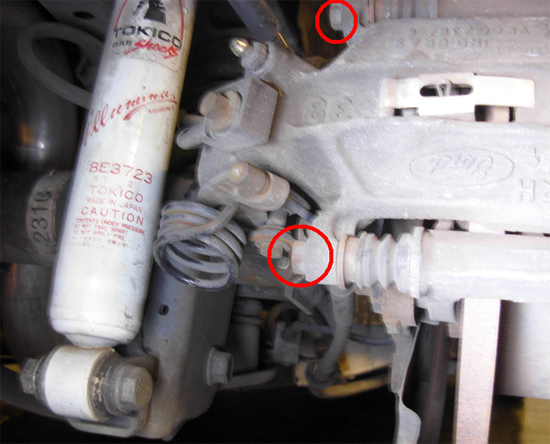
Wheel hub assembly. Lower caliper bolt circled in red.
5. Slide the caliper off the rotor and secure it in the wheel well using a bungee cord or string in a location and orientation that minimally stresses the brake line. One convenient location to tie off the string is the upper shock.
Warning!In this step, you will be removing the caliper! Make sure to have a way to secure it up in the wheel well in such a way that the brake line is not stressed!
6. Remove brake pads out of the pad/caliper housing. They should just slide out of their tracks. There is one on each side of the rotor.
7. Remove the two 15mm bolts that attach the pad/caliper housing to the car using the ratchet and 15mm socket. Refer to picture below for the location of the bolts. Then remove the pad/caliper housing from the rotor.
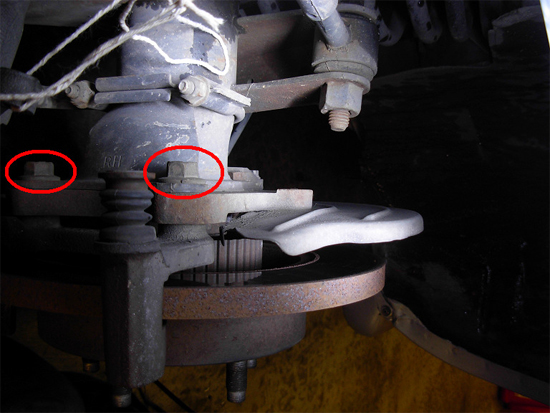
Inside of pad/caliper housing (on backside of the rotor). The 15mm bolts are circled in red.
8. Pry off any rotor retainers that are holding the rotor on the studs. Slide the brake disk off the wheel studs. You may need to hit it with a rubber mallet and use penetrating oil where the rotor encircles the wheel hub to break the rust loose to free it for removal.

Wheel hub and rotor. Rotor retainers circled in red.
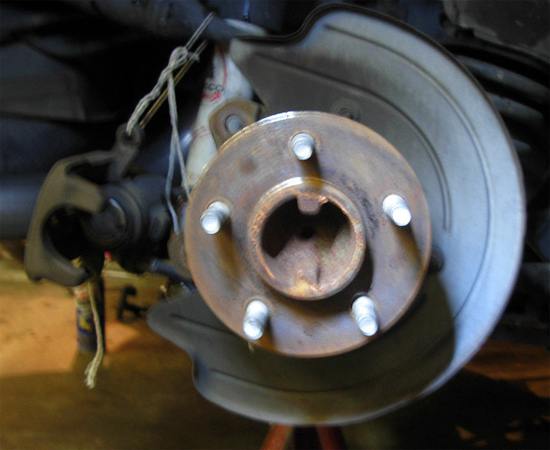
Wheel hub. Your car should look like this once you have the rotor off.
9. Clean both surfaces (front and back) of the new rotor with brake cleaner and paper towel. Keep applying cleaner and wiping with new towels until the towel comes out clean. Pay special attention to slot trenches. Use latex gloves for this step so that you don’t get your skin oils on the rotor after you clean the rotor surface.
10. Slide new PowerSlot rotor onto your wheel studs. Make sure the one with the white “R” sticker on it goes on the passenger side. Also, the white sticker should be showing when you put it on. If the sticker side is facing into the center of the car rather than out to you, then you have put the rotor on backwards.
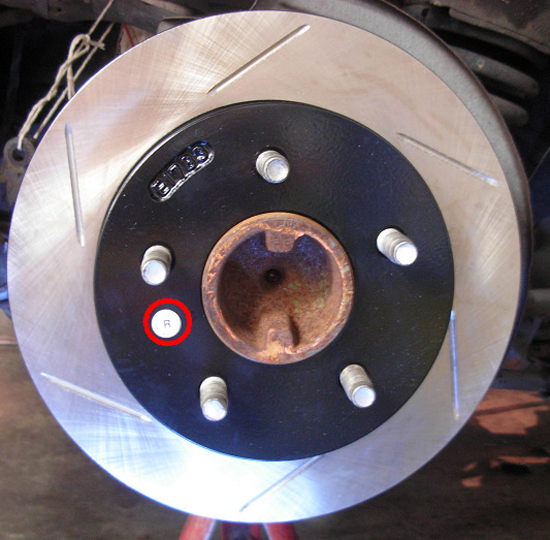
PowerSlot rotor installed on wheel hub. Notice the circled white “R” sticker is facing out.
11. Peel off the white “R” (or “L”) sticker.
12. Bolt the pad/caliper retainer back onto the car with the two 15mm bolts using the ratchet and 15mm socket. Snug the bolts tight.
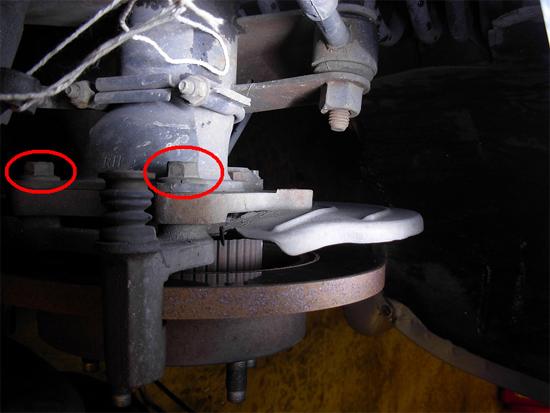
Inside of pad/caliper housing (on backside of the rotor). The 15mm bolts are circled in red.
13. Now you will need to bleed your brakes.
Warning!During this entire step, do not allow the piston to recompress when the brakeline valve is open! If you do, you will introduce air into your brake lines.
14. Snug the rear brake compressor tool into position as shown below with the two keys of the driver interlocked with the caliper piston.
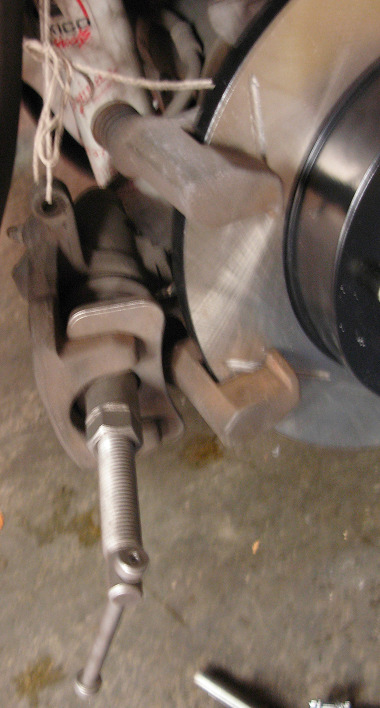
Brake compressor snugged onto piston.
15. Attach rubber hose of the brake-bleeding tool you constructed earlier to the barb of the brake bleeder valve.
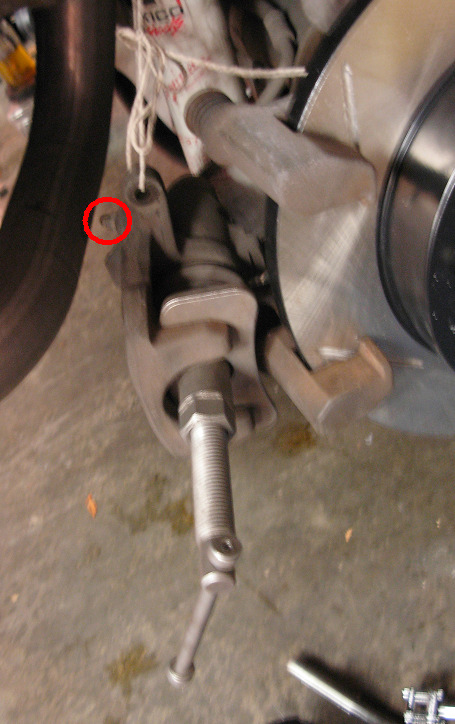
Brake caliper. The bleeder valve is circled in red.
16. Loosen bleeder valve nut with the 11mm wrench ¼ turn.
17. Compress piston until it is flush as shown below with the brake compressor tool. You should feel the piston bottom out.
18. Tighten bleeder valve until just snug.
19. Remove brake compressor from piston.
Warning!Did you first tighten the bleeder valve? If not, do so before proceeding with this step.
20. Use the brake part lubricant to grease the metal backs of new pads and the brake pad seats in pad/caliper retainer (see photo below)
Warning!Make sure to not get any lubricant on the rotor surface. If you do, clean the rotor thoroughly with the brake cleaner.

Pad/caliper retainer with pads installed. Notice the red grease on the pad back and in between the pad and the retainer.
21. Slide your new brake pads into the pad seats as shown in the above figure.
22. Slide the brake caliper over the new pads and fasten it with the two 13mm bolts using the ratchet.
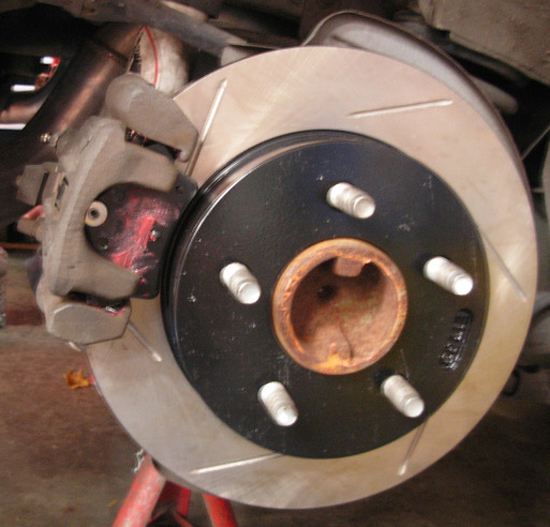
Brake caliper installed over new pads.

Wheel hub assembly. Caliper bolts circled in red.
23. Repeat these instructions for the driver side and then continue below***
24. Bleed rear calipers using the 11mm wrench and brake-bleeding tool you constructed. If your brake system has not been flushed in a while, this may be a good time to do so. If you do decide to flush the entire system, star with the wheel farthest from the master cylinder. This is the passenger-side rear wheel. Then work your way towards the master cylinder, bleeding all four calipers. The front caliper bleeder valves use a 3/8" wrench.
25. Burnish your new pads per the pad manufacturer’s instructions. A link to these instructions can be found here.
Installation instructions provided by AmericanMuscle customer Jeff Braun 12.21.09










